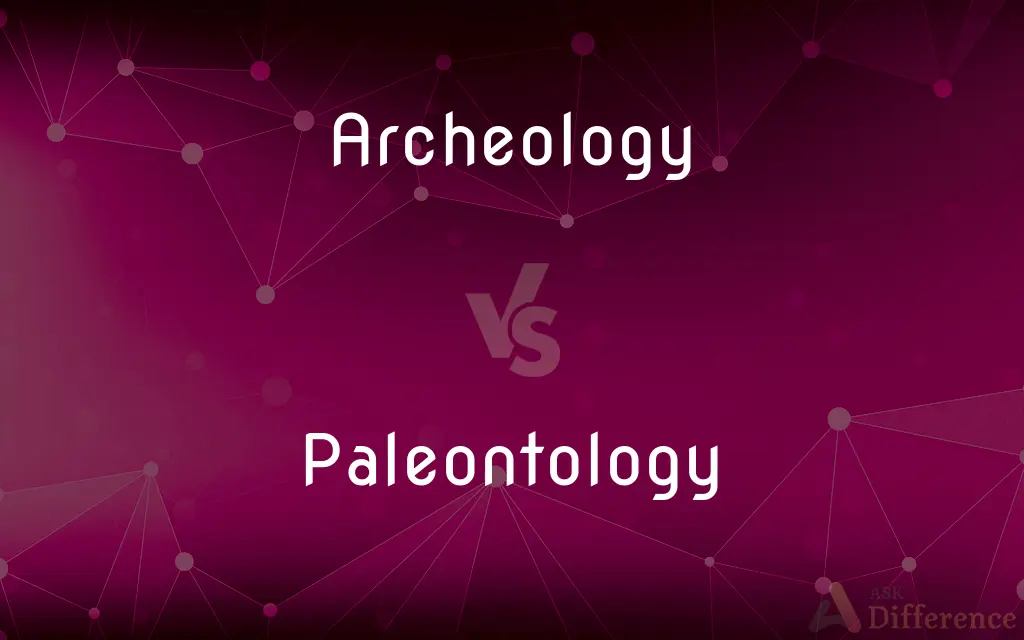Archeology vs. Paleontology — What's the Difference?
By Urooj Arif & Maham Liaqat — Updated on March 13, 2024
Archeology focuses on human past through artifacts, while Paleontology studies ancient life via fossils.

Difference Between Archeology and Paleontology
Table of Contents
ADVERTISEMENT
Key Differences
Archeology is the scientific study of human history and prehistory through the excavation and analysis of artifacts, structures, and cultural landscapes. It aims to understand human behavior and cultural development over time. On the other hand, Paleontology is the branch of science concerned with the history of life on Earth through the study of fossils. This includes the study of plants, animals, and microorganisms from millions of years ago to the recent past.
Archeologists often focus on material remains such as tools, pottery, and ruins of buildings to piece together the lifestyles, customs, and societies of ancient peoples. Paleontologists use fossils to understand the evolution and interaction of life forms throughout Earth's history.
While both fields involve digging and the study of the past, archeology centers on human artifacts and historical contexts, whereas paleontology deals with the broader spectrum of ancient life forms preserved in rocks. Archeological findings might include tools, artwork, and structures, while paleontological discoveries often encompass fossils of animals, plants, and microorganisms.
Archeology and paleontology both contribute to our understanding of the Earth's history, but they do so from different perspectives. Archeology helps us comprehend human civilization's development, cultural practices, and societal changes. In contrast, paleontology provides insights into the Earth's biological history, including the evolution of species and the environmental conditions that influenced their survival and extinction.
In terms of methods, archeologists often employ stratigraphy, typology, and radiocarbon dating to analyze and date artifacts and sites. Paleontologists, however, rely on techniques such as radiometric dating and biostratigraphy to determine the age of fossils and understand the paleoenvironmental conditions.
ADVERTISEMENT
Comparison Chart
Focus
Human history and culture
Ancient life forms
Methods
Excavation, stratigraphy, typology
Fossil analysis, radiometric dating
Findings
Artifacts, structures, human remains
Fossils of animals, plants, microorganisms
Aim
Understand human behavior and cultural development
Study evolution and interaction of life forms
Timeframe
Human history (millions of years to present)
Earth's history (billions of years to present)
Compare with Definitions
Archeology
Focuses on cultural and societal developments.
Discovering ancient pottery can reveal trade routes and cultural exchanges.
Paleontology
Investigates ancient life through fossils.
A paleontologist might study dinosaur bones to understand their physiology and behavior.
Archeology
Aims to piece together human lifestyles and customs.
Analyzing cave paintings can provide insights into early human spirituality and community life.
Paleontology
Encompasses the study of plants, animals, and microorganisms.
Examining fossilized pollen can help reconstruct ancient climates and ecosystems.
Archeology
Studies human history through artifacts.
An archeologist might excavate a Roman villa to understand daily life in ancient Rome.
Paleontology
Aims to understand the evolution of life on Earth.
Studying the fossil record can reveal how life forms adapted to changing environments.
Archeology
Interprets material remains to reconstruct past societies.
Studying the layout of an ancient city can reveal its social and economic structure.
Paleontology
Uses techniques like biostratigraphy and radiometric dating.
Radiometric dating can determine the age of a fossil by measuring isotopes in surrounding rocks.
Archeology
Employs methods like stratigraphy and radiocarbon dating.
Radiocarbon dating can determine the age of wooden tools found at a site.
Paleontology
Provides insights into Earth's biological history and paleoenvironments.
Analyzing marine fossils can indicate the location of ancient seas and ocean conditions.
Archeology
Variant of archaeology.
Paleontology
Paleontology (), also spelled palaeontology or palæontology, is the scientific study of life that existed prior to, and sometimes including, the start of the Holocene epoch (roughly 11,700 years before present). It includes the study of fossils to classify organisms and study their interactions with each other and their environments (their paleoecology).
Archeology
(American spelling) archaeology
Paleontology
The study of the forms of life existing in prehistoric or geologic times, as represented by the fossils of plants, animals, and other organisms.
Archeology
The branch of anthropology that studies prehistoric people and their cultures. Same as Archæology, etc.
Paleontology
(American spelling) Study of the forms of life existing in prehistoric or geologic times, especially as represented by fossils.
Archeology
The branch of anthropology that studies prehistoric people and their cultures
Paleontology
The science which treats of the ancient life of the earth, or of fossils which are the remains of such life.
Paleontology
The earth science that studies fossil organisms and related remains
Common Curiosities
How do paleontologists date fossils?
Paleontologists often use radiometric dating and biostratigraphy to determine the age of fossils and understand the paleoenvironmental conditions.
What is the main focus of archeology?
Archeology primarily focuses on studying human history and prehistory through artifacts and material remains.
Can archeology and paleontology findings overlap?
Yes, in some cases, such as the study of ancient human remains or the use of fossilized plant material in archeological contexts, the findings of archeology and paleontology can overlap.
What kind of artifacts might an archeologist find?
An archeologist might find tools, pottery, artwork, and structures, among other material remains.
How do archeological discoveries contribute to our understanding of human history?
Archeological discoveries help us understand human civilization's development, cultural practices, and societal changes throughout history.
How does paleontology differ from archeology in terms of its focus?
Paleontology focuses on studying ancient life forms, including plants, animals, and microorganisms, through the analysis of fossils.
What are some common methods used in archeology?
Archeologists use methods such as excavation, stratigraphy, typology, and radiocarbon dating to analyze artifacts and sites.
What is the significance of fossils in paleontology?
Fossils are crucial in paleontology as they provide direct evidence of ancient life forms and their environments, helping to reconstruct Earth's biological history.
What does paleontology reveal about Earth's history?
Paleontology provides insights into the biological history of Earth, including the evolution of species and the environmental conditions that influenced their survival and extinction.
How does paleontology help in understanding evolution?
By studying fossils, paleontologists can trace the lineage of species, observe evolutionary changes, and understand the factors that led to the emergence or extinction of species.
How can archeological findings impact our view of historical events?
Archeological findings can provide new insights or evidence that challenges previous understandings of historical events, leading to revised interpretations of human history.
In what ways can paleontological discoveries impact our understanding of climate change?
Paleontological discoveries can offer valuable data on past climates and environmental conditions, helping scientists to model and predict future climate change scenarios based on historical patterns.
How is stratigraphy used in archeology?
Stratigraphy involves analyzing the layers of soil and sediment at an archeological site to understand the chronological sequence of human activity.
What role does radiocarbon dating play in archeology?
Radiocarbon dating is used to determine the age of organic materials, helping archeologists to date artifacts and sites accurately.
Are there interdisciplinary areas between archeology and paleontology?
Yes, areas such as paleoethnobotany and zooarchaeology intersect both fields, focusing on the study of ancient plant remains and animal bones in archeological contexts.
Share Your Discovery

Previous Comparison
Sustenance vs. Subsistence
Next Comparison
Beggar vs. PanhandlerAuthor Spotlight
Written by
Urooj ArifUrooj is a skilled content writer at Ask Difference, known for her exceptional ability to simplify complex topics into engaging and informative content. With a passion for research and a flair for clear, concise writing, she consistently delivers articles that resonate with our diverse audience.
Co-written by
Maham Liaqat















































